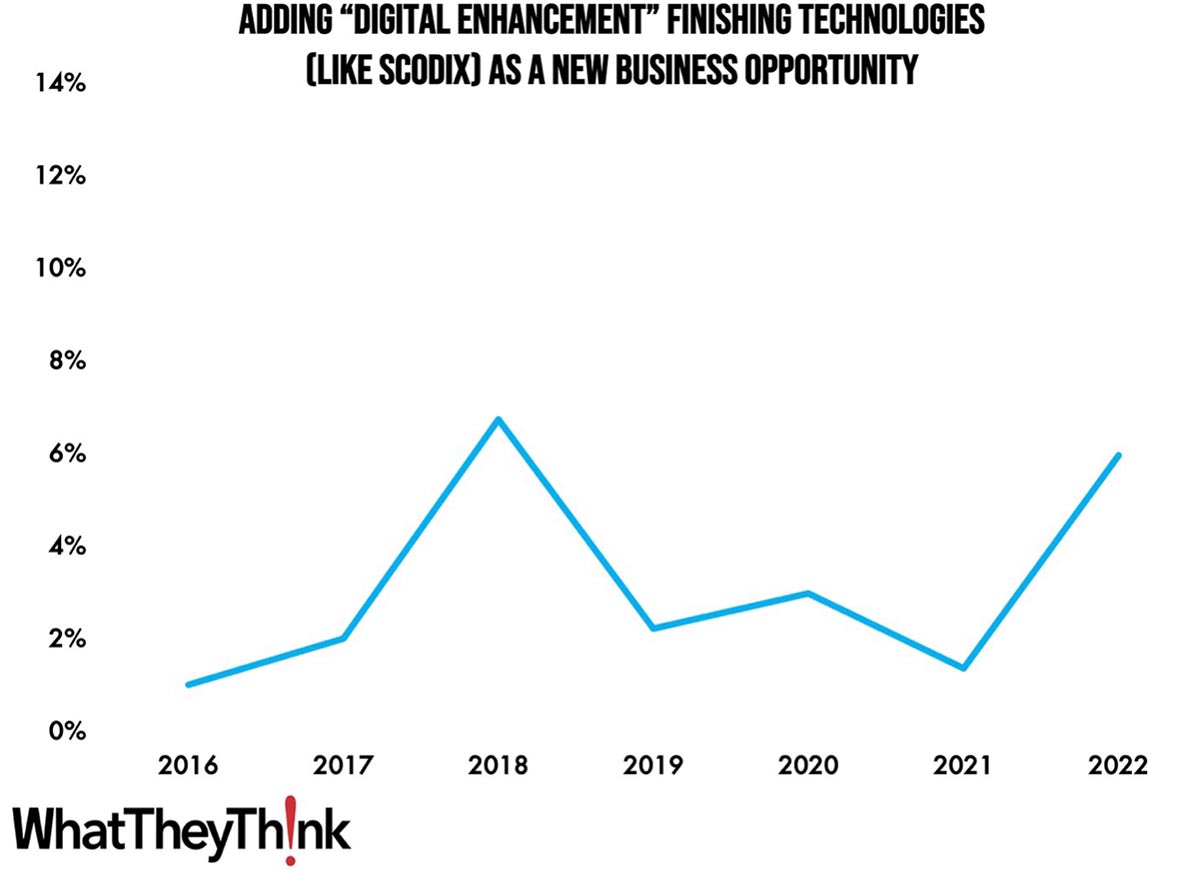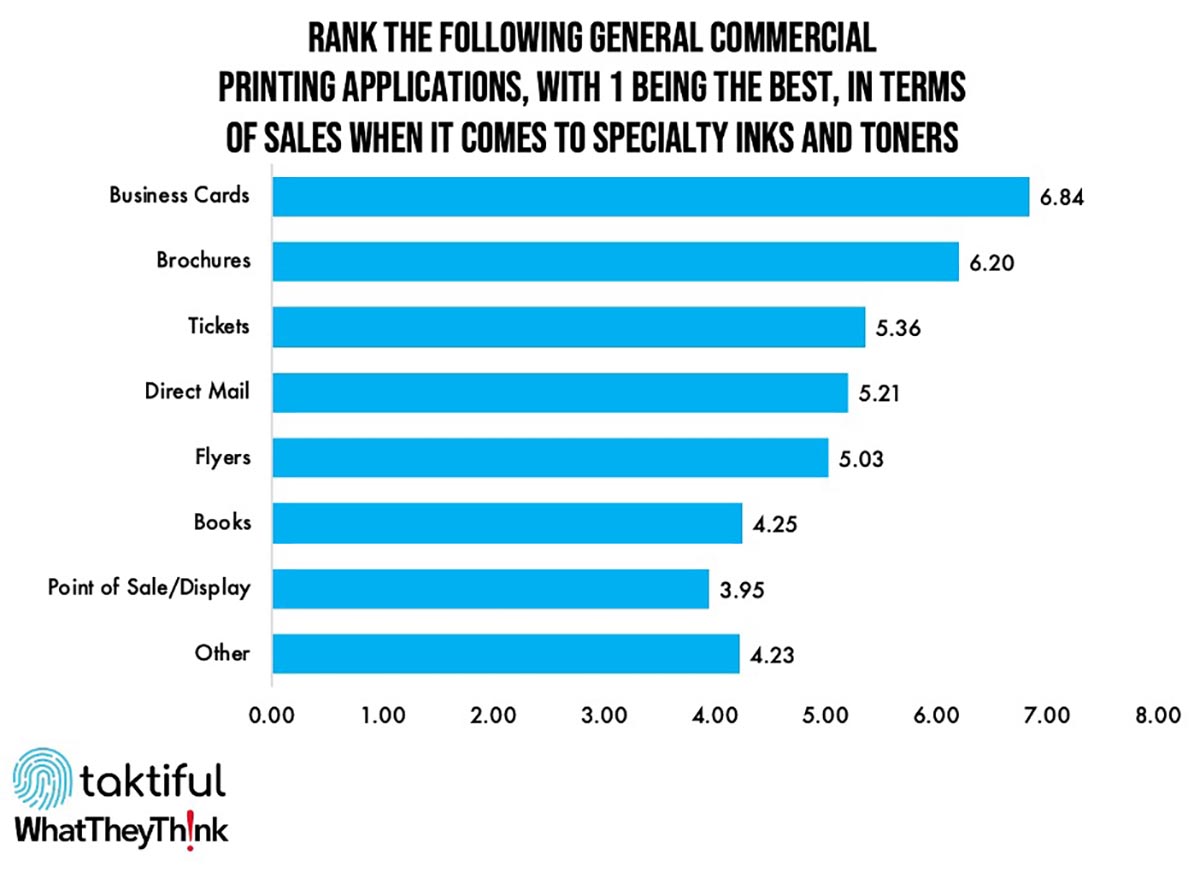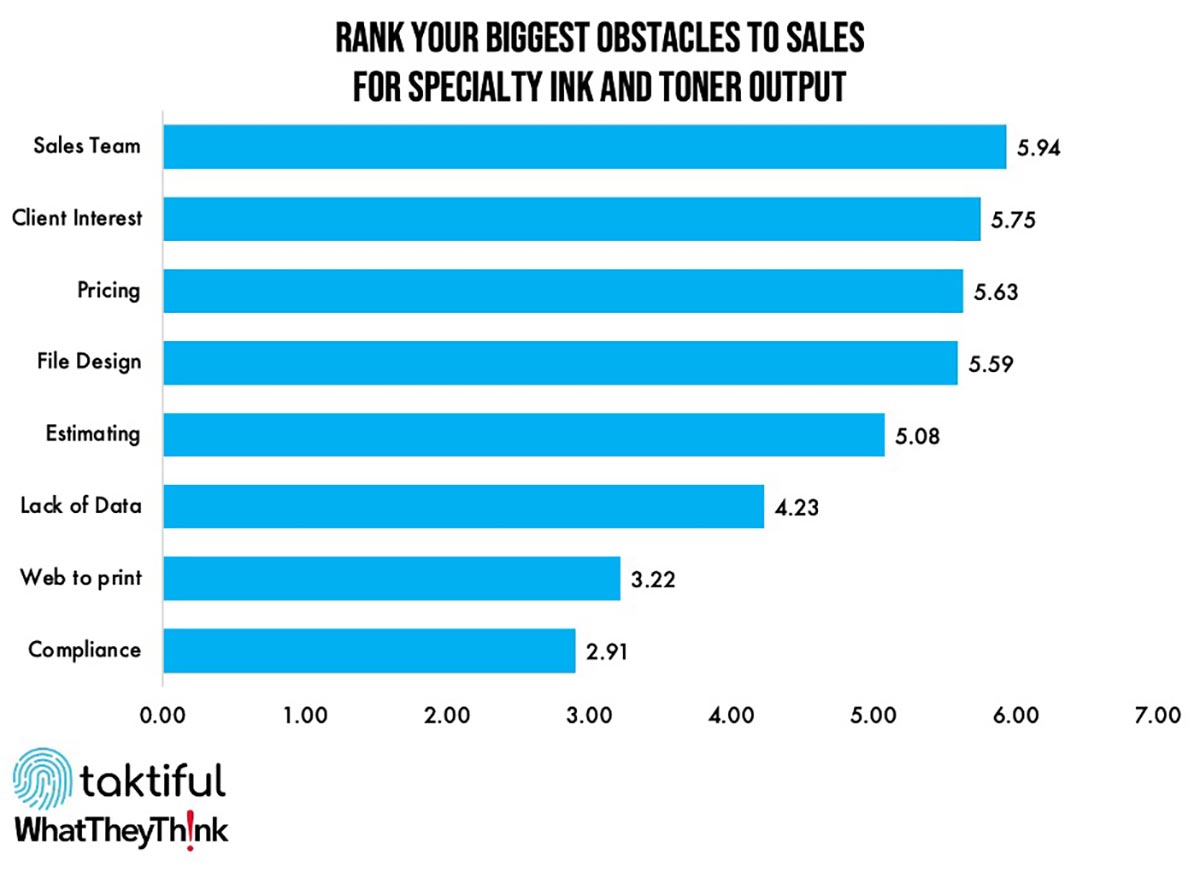We at WhatTheyThink have been beating the drum for embellishments for the past few years, but as I have bemoaned fairly regularly round these parts, they have yet to be seized upon by the printing industry. Indeed, our annual Print Business Outlook surveys have regularly found that digital embellishments have not been perceived as much of a new business opportunity—at most, only 6% of survey respondents ever saw an opportunity in these technologies. We’ve always found this to be a missed opportunity.

It’s up substantially in 2022—but then it had also been up in 2018, although there were some, ah, mitigating circumstances in a few of those years.
Defining Our Terms
First, what exactly are we talking about? The techniques and technologies go by many names—“embellishments” and “enhancements” are the two we encounter most often, and they comprise a wide variety of analog and digital processes, such as the staggering variety of foil and metallic effects, embossing/debossing, laminating, die-cutting, laser etching, doming, and the host of digital “embellishments” perhaps best exemplified by machines from Scodix, MGI, Kurz, and others. Some of these are cutting-edge finishing technologies, while others have been around for literally centuries. What we are predominantly looking at in this article are digital “embellishments” in general, and, more specifically, “specialty ink and toner capabilities,” which means adding embellishments and enhancements via the fifth-color option on a digital press.
(Kevin Abergel and Trish Witkowski have an essential primer on the full gamut of embellishments and effects.)
Why the Lack of Interest?
We’ll be looking more closely at this when we conduct our Fall 2023 Print Business Outlook Survey (consider yourselves warned), but some possibilities include lack of interest from customers, potential expense of adding these capabilities without a ready market, perceived difficulty in designing and producing them—and it’s likely that some combination of those factors are at play. Another that I have come across is that there is the perception that embellishments are “too good” for the kinds of print jobs that printers often produce. And I can see that; you go to shows and the vendors are all showing off these amazing, high-end print applications—but not everyone produces marketing materials for the likes of Rolex or Godiva or other “luxury” brands. It’s not easy to come across more prosaic, but equally as effective, examples of embellishments on the kinds of things printers most often print.
But there are plenty of examples that printers are producing, and a fair number of them are identified in the recent Taktiful/WhatTheyThink 2023 Specialty Digital Ink and Toner Embellishment Study. The goal of this study was to find out more about how print service providers are using the specialty inks and toners that are available as options for their digital presses. Now, that’s a fairly limited look at the much broader universe of embellishments—much less digital embellishments—but we can extrapolate some of the findings to other kinds of applications, and use the data gleaned from this survey to inspire a more extensive study of the state of embellishments. So the top print applications for which digital press owners are using embellishments are:

We also asked an open-ended question about other specialty ink and toner applications not included on our survey. Here is a sampling of their responses:
- Funerals
- Wedding industry
- Fine art
- Small packaging
- Postcards
- Replacing CMYK digital jobs with PMS jobs
- Static cling consumer stickers
- Invitations
- Credentials/IDs/Backstage passes
- Greeting cards
- Specialty packaging
- Brand protection
- Security business applications
- Events
- Calendar printing
- Printing Pantone colors
- Clear red fluorescing ink
- Stationery
With a little imagination, embellishments don’t need to be solely the purview of upmarket brands and applications.
Success with Embellishments
One of the notable things we found when reviewing the survey results was that users got the best results when they stepped up their marketing efforts for them. Always the way, isn’t it? But the key factor in achieving success with embellishments involved training sales personnel. We found in the study that not too many respondents put their sales staffs through extensive training on how to sell these applications—at their cost. Specifically:
- 21% of shops whose sales staff received “a great deal” of training reported being “very satisfied” with the profits from their specialty ink and toner jobs, compared to 12% overall.
- 30% of shops whose sales staff received “a great deal” of training reported being “very satisfied” with the sales of those jobs, compared to 9% overall.
And according to survey respondents, the biggest obstacle to sales of specialty ink and toner output was…sales. We asked our survey respondents to rank a list of obstacles on a scale from 1 to 8 where 1 was the biggest obstacle and 8 the smallest, and “sales team” just beat out “client interest” as the biggest obstacle.

At the End of the Day
Print businesses primarily added specialty ink and toner capabilities in order to have it be a profit center, although customer demand also was a factor. And while users are generally satisfied with the profitability of the specialty ink and toner jobs they are producing, they are less satisfied with sales—so more sales and marketing effort is needed to make these jobs as profitable as they potentially can be. Ultimately, the opportunity lies in getting print samples under customers’ noses—or, in those cases where the end user is the customer’s customer (in the case of agencies)— noses up the food chain.
If you’re interested in taking advantage of specialty ink and toner effects and, more broadly, embellishments, there is a lot of good data in the report to get you started and see how your peers have tackled the embellishments space. The report is available at the WhatTheyThink eStore. Site licenses, as well as packages including customized data cuts, slide decks, and other resources are also available.















Discussion
By Kate Dunn on Aug 04, 2023
Sales reps who think they are selling embellishments will struggle to sell the capability. Reps who realize they are selling the business results that embellishing print delivers will be successful.
Discussion
Join the discussion Sign In or Become a Member, doing so is simple and free